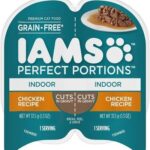It’s a question many cat owners have pondered, especially if they also own a dog: “Does Dog Food Hurt Cats?” The simple answer is that a small amount of dog food probably won’t cause immediate harm. However, consistently feeding your cat dog food can lead to serious health problems. This article dives into the nutritional differences between cat and dog food, explaining why a cat’s long-term health depends on a diet specifically formulated for felines.
The Dangers of Long-Term Dog Food Consumption for Cats
While a stolen nibble of dog food here and there is unlikely to cause immediate problems, cats should not be fed dog food as a primary diet. Over time, a diet consisting solely of dog food can have detrimental and even deadly consequences for your feline companion. This is because cats and dogs have vastly different nutritional requirements, and their respective foods are formulated accordingly.
Alt text: A cat curiously eating from a bowl filled with dog kibble, highlighting the potential for accidental consumption of dog food by cats.
Cats vs. Dogs: Understanding the Nutritional Divide
Although both cats and dogs share our homes and hearts, evolution has shaped them into distinct species with unique nutritional requirements. Understanding these differences is key to ensuring your cat’s well-being.
Cats are obligate carnivores. This means their bodies are designed to thrive on a diet primarily composed of animal-based proteins and fats. These nutrients are essential for the proper functioning of all their bodily systems. Dogs, on the other hand, are omnivores, capable of digesting and utilizing both meat and vegetables. Consequently, dog food formulations don’t provide the specific nutrients cats need in the right proportions.
Key Nutritional Differences Between Cat and Dog Food
Several crucial differences in formulation distinguish cat food from dog food.
Taste and Palatability
Cats and dogs have different taste perceptions. Unlike dogs, cats lack the ability to taste sweetness. Additionally, cats possess far fewer taste buds than dogs – only around 470 compared to a dog’s 1700. For comparison, humans have over 9000 taste buds! Cat food is therefore carefully designed to be highly palatable, enticing these often-picky eaters.
It’s worth noting that cats are generally less interested in dog food, finding it less appealing than their own food. Dogs, however, are often drawn to the high-protein content in cat food.
Protein Content
As obligate carnivores, cats require a significantly higher protein content in their diet compared to dogs. While some dog food brands may offer higher protein options, even these specialized formulas typically don’t meet the protein levels necessary for optimal feline health.
Most dog foods contain an “As-Fed” protein amount of 18-26%. For cats, a target of at least 30-34% “As-Fed” protein is recommended, with the option of supplementing with canned cat food containing 40-50% protein.
Taurine: An Essential Nutrient
Taurine is an essential amino acid that cats (and humans) cannot produce on their own. They must obtain it through their diet. Taurine deficiency in cats can lead to severe health problems, including:
- Weakened heart function (dilated cardiomyopathy)
- Vision loss
- Digestive issues
Most commercially available cat foods are supplemented with taurine, while dog foods rarely include it.
Alt text: A detailed view of dry cat food kibble, emphasizing the careful formulation designed to meet the specific nutritional requirements of cats, including the addition of essential nutrients like taurine.
Arachidonic Acid: A Vital Fatty Acid
Arachidonic acid is another fatty acid that cats cannot synthesize and must obtain through their diet. Low levels of arachidonic acid in cats can result in:
- Abnormal liver and kidney values
- Skin problems
Dogs can produce arachidonic acid on their own, so dog food is rarely supplemented with it.
Vitamin A: Essential for Various Bodily Functions
Vitamin A is yet another nutrient that cats cannot produce internally and must receive through dietary supplementation. While dog foods often contain Vitamin A, the levels are insufficient for optimal cat nutrition. Vitamin A deficiency in cats can lead to:
- Poor coat quality
- Muscle weakness and deterioration
- Possible night blindness
Niacin: Important for Metabolism
Cats also require niacin in their diet, as they cannot synthesize it themselves. Animal tissue is a primary source of niacin in cat food. Foods with lower animal tissue content and higher plant tissue content (like grains) may not provide cats with adequate niacin levels.
Life Stage Considerations
The Association of American Feed Control Officials (AAFCO) regulates the pet food industry, ensuring pet foods meet established nutritional standards. Pet foods that adhere to AAFCO’s guidelines will include a label stating that the product is “…formulated to meet the AAFCO Cat Food Nutrient Profile for… (a life stage).”
Nutritional needs vary depending on a cat’s life stage, which are generally categorized as:
- Growth (Kittens)
- Maintenance (Adult Cats)
- All Life Stages
Kittens require more nutrients and energy for rapid growth, while older cats need more protein to maintain muscle mass. Dog food, with its lower nutrient levels, cannot adequately support a cat through any of these life stages.
The Importance of High-Quality Cat Food
Feeding your cat a healthy, high-quality diet specifically formulated for felines is crucial for their long-term health and well-being. While a few bites of dog food won’t cause immediate harm, it’s not a substitute for proper cat nutrition. Choose a cat food that meets AAFCO standards for your cat’s life stage to ensure they receive the nutrients they need to thrive.
